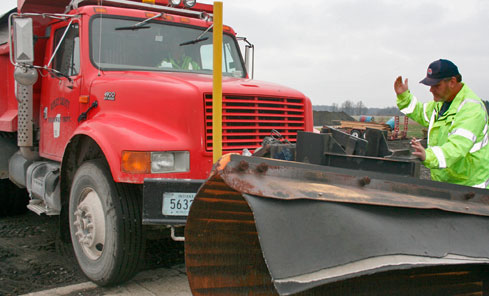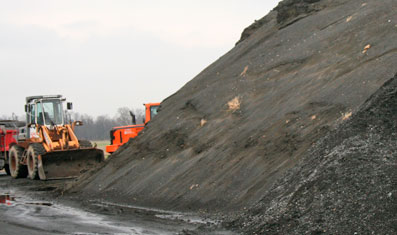County’s 14 trucks cover 720 miles
Road crews were ready for winter
Mary Mattingly
EDITOR
mmattingly@ripleynews.com
The first major snowstorm of the season came early, but the town, county and state road crews were ready. “As a rule we don’t usually get a storm this early. It’s usually after Christmas,” said Bob Deburger, on Thursday. He’s the foreman for district three of the county highway department. If the Farmer’s Almanac or the wooly worm, for that matter, are right, this is just the beginning of a long winter.

MARY MATTINGLY PHOTO
Pictured right, Mike Scott with the Ripley County Highway Department District 3 prepares Thursday afternoon to place the snow blade/plow on the county truck.
The forecasts started early last week, and by Thursday, up to 10 inches of snow and a half inch of ice were predicted for Friday. Kids got their first snow day of the year, as all schools in the county were closed due to road conditions Friday morning. There was mainly sleet and ice to contend with at that time, but the snow started falling heavy by mid-morning. A little over six inches of the white stuff was dumped by the end of the day in many parts of the county. Holton probably had the most with reports of 6.8 inches; Osgood, 6 inches. School was also on a two hour delay Monday.
The county road crews loaded their red trucks with snow plows Thursday and salt/cinder, and continued to do so over the next two days. The single axle trucks hold eight tons, the double axle, 12 tons. They were out Friday by 5 a.m., and also worked most of Saturday to keep roads clear.
“We never have enough trucks when you get a big snow,” Deburger said. They have 14 trucks to cover about 720 miles of road, plus three graders. Commissioner Robert Reiners commented, “And that’s just one way. They have to plow 720 miles, so that’s 1440 miles.” It can’t be done in eight hours, and usually takes 12 to 14 hours complete, notwithstanding breakdowns, accidents, or more snow/ice.
The county roads that get priority are the ones most traveled, i.e. Michigan Road. The county is divided fairly evenly into three districts for the highway department to cover. Commissioner Mark Busching oversees district 2, and said Olean Road and 300 North, besides Michigan Road, are pretty well traveled, and hit quickly by the road crew. “We always get lots of requests or calls asking us to get to somebody’s street. We try to get to it as soon as possible,” he said. District 1 covers Batesville, Morris, Penntown, 229 by Napoleon, and district 3 goes from 700 South to Friendship and near the Jefferson Proving Ground.

MARY MATTINGLY PHOTO
The county highway department in Osgood has piles of cinder to mix with salt to treat the roads. The cinders help provide traction for the roads. They went through a lot of it as the 14 trucks were used continuously Friday and Saturday, but there is still plenty for the season.
Last year was a mild winter, which means the county has salt and cinders leftover. A new county salt storage center was built in 2012 and stores over 600 tons. Reiners said they also lay brine down at stop signs, hills and curves, and the EMS building in Delaware. District 1 also gives preference to Six Pine Ranch Road since the Hansen Health Center is located there.
They didn’t have a lot of overtime at the highway department because of the mild winter, but it’s always an estimate at budget time. Steve Schonegg, with district 1, said in the past two days, the 14 trucks went through a lot of the mixture, but they still have plenty stored for the season. He noted the cinders don’t melt so it’s a good combination with the salt to provide traction at intersections.
Many of the heavily traveled roads in the county are state roads. The state has two highway departments in the county, one in Versailles and another in Penntown. The Versailles state department has four trucks (yellow) and four workers, who rotate shifts to cover 180 miles, mainly in Ripley County. Crew leader Ron Miller got pulled to work the midnight shift, starting Thursday. He’s been at the local district for 29 years. They use straight salt to treat the roads.
Which state roads get priority?
“US 50 and US 421” Miller replied, and that’s also because they are most heavily traveled. He also added that north SR 129 is important because it leads to a hospital in Batesville. It’s also their longest route, and very open, which leads to drifts and can be hard to maintain for clear roads, Miller said. There’s also SR 62, 350, 46, 48, 101, to name several in the county.
The county and state road crews are in communication with the school district transportation directors, and sheriff’s office, on the status of the roads. Often, calls are made around 2 or 3 a.m. so the crews would have time to clear roads if school is on. Cities or towns like Osgood and Batesville, also use their own street departments to help clear roads.
Police say the roads that are most heavily traveled also are prone to be the ones with the most accidents. However, Miller mentioned hilly US 421 by Napoleon and bridges by US 350 in Osgood tend to be troublesome spots. Sgt. Noel Houze, public information officer with the state police post in Versailles, has a different perspective since they cover the interstate as well. “There are more accidents on the interstate because people drive faster. They think slowing to 55 mph is fine on the interstate, but it’s not when the roads are icy.”
Snow vs. ice?
Without hesitation, Miller replies, “I’d rather have 20 inches of snow than ice.” Deburger agrees. “I’d push 6 inches of snow than deal with frozen rain. It’s just bad to drive on. And people think these trucks can go anywhere, and it’s not the case with ice.” Utility crews don’t like ice either, as it often brings down tree limbs, pulling power lines down with it. Barry Lauber with Southeastern Indiana REMC said they monitor weather forecasts and have crews on standby, anticipating such outages from weather issues.
Miller recalls a time many years ago when he was driving a state truck and it flipped. It didn’t have the heavy load in the back, which helps weigh it down. Fortunately, he wasn’t hurt.
The road crews recall ice storms four years ago, and a time when 26 inches of snow was dumped around Christmas time. The winter in the late ‘70s, Busching recalls, bulldozers were used to clear roads. “The snow was higher than the vehicles!”
Advisories
Commissioners are responsible for issuing a travel advisory, and did issue an advisory (use caution) Friday. (Many people get this by signing up for the state or county law enforcement Nixle automatic notification electronic service.) Reiners said they take the task seriously, conferring with police, road crews and more. “It’s a touchy thing and we put a lot of thought into it,’ he said, knowing the advisory can affect factories and employment. They try to use the most severe, level three, sparingly because of that. But the more vehicles on the road, the harder it is for the road crews to do their job. “If they get stuck, then the county can’t get through, or maybe the EMS, or fire department. A lot disregard the warnings and do what they want,” Reiners said.
The county follows the state department of transportation advisory designations. A level one, “yellow” travel “advisory” is notification that travel may be restricted in some areas. Under a “watch” level 2 or “orange” status, means only essential travel is recommended. A travel advisory at a “warning” level, or level 3 and red, means travel may be restricted to emergency personnel only.
DO NOT call city, county or state police to check on road conditions – police agencies across the state want to keep phone lines open for emergency phone calls. Dial toll-free 1-800-261-ROAD (7623) for updated Indiana travel information, including road conditions, road closures, crashes and other traffic alerts.
Advice from police, road crews: ‘Slow down!’
“Every year with the first snow, it’s as if people forgot how to drive in it, they have to be re-doctrinated,“ says Sgt. Noel Houze, public information officer with the state police post in Versailles. That was likely the case Friday with the first major snowstorm of the area. He, and other law enforcement officers, and even road crews, repeat the mantra at this time of year to motorists. “Slow down!” Houze also advises to allow more time to get to your destination, and put more distance between vehicles on the road. “This gives you more time to react.. Be a defensive driver. “
Sheriff Thomas Grills said the biggest factor for accidents at this time of year is speed. “The second would be equipment failures such as tires and issues with windshields not being clear due to wipers, or heaters not working.” He noted the sheriff’s office has four, four-wheel drive vehicles which help greatly with response during snow or icy conditions.
State police also advise to clear off the car before you hit the road, even the hood. “Scrape the whole car, and not just a little porthole on your windshield.. Even get the lights and taillights so others see you,” Houze said.
Road crews also have advice for motorists. “If you see one of our trucks, slow down, and give it room. We are putting out material so it’s best to steer clear,” said Ron Miller with the state department in Versailles. Commissioner Mark Busching agrees. “Give them clearance and the room they need.”
 Headlines • December 10, 2013
Headlines • December 10, 2013


